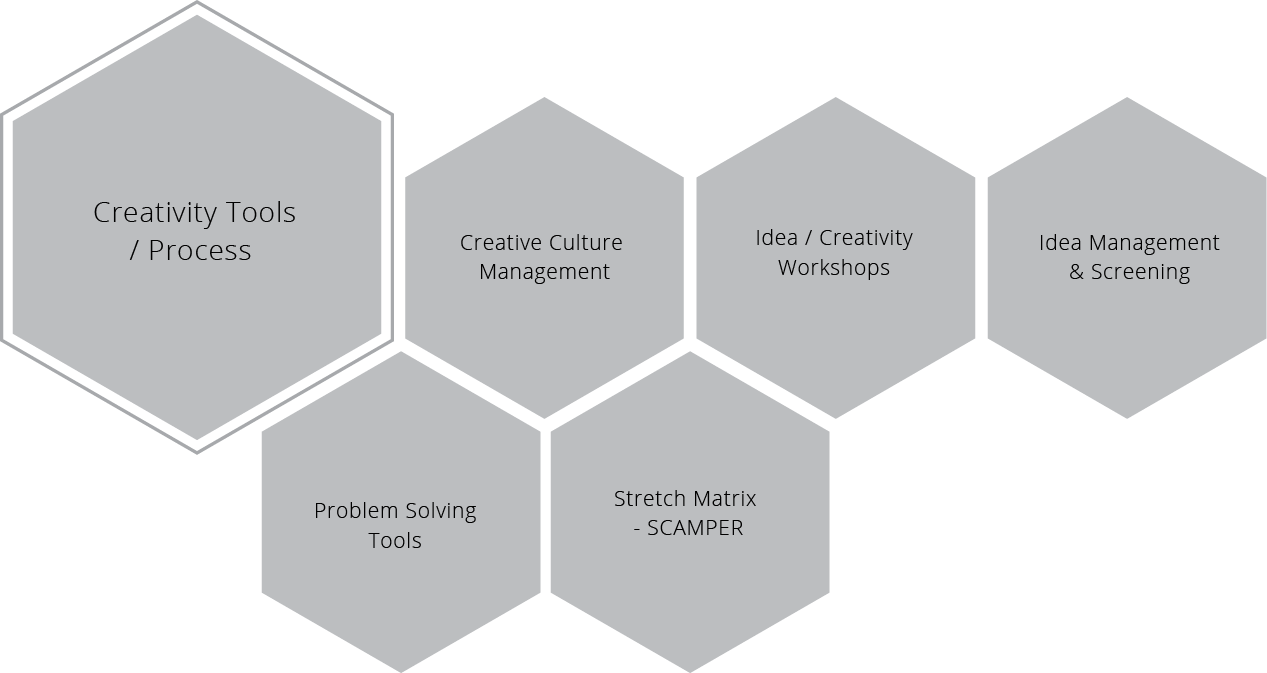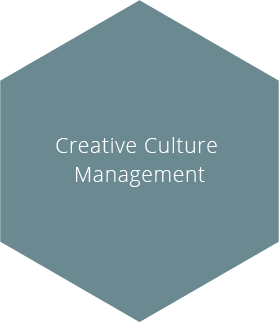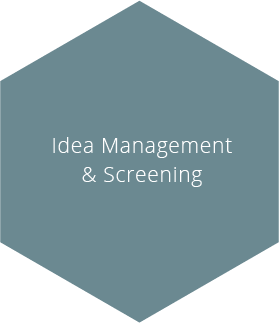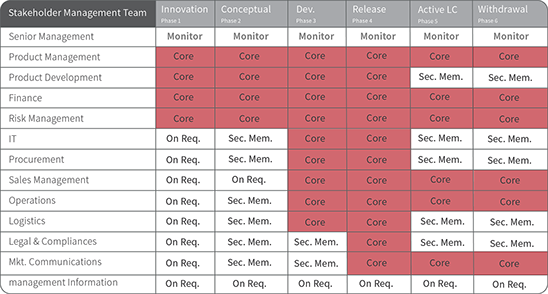Glossary
Logout
©Copyright Arcturus 2022, All Rights Reserved.
7
Terms & Conditions
|
|
|
|
Security & Privacy
Contact
IDEA / CREATIVITY WORKSHOPS
|Introduction
‘The Problem is not generate new ideas but to get rid of old ideas’

|Timeframe for Creativity
Creativity and Problem solving techniques are not just a series of techniques that are only employed in a specific moment of time within the PM Phases. They can be used wherever or whenever there is a need to structure creativity or indeed solve a specific problem.
The process of blue sky thinking and process management will lead to innovative products. Remember that innovation is a process of applying creativity. Innovation is a direct route to product differentiation and in turn will lead to genuine competitive edge.

|Edward deBono - Six Thinking Hats
Facts and Truths
Emotions and Feelings
Critical / Pragmatic
- Evidence based
- Source
- Direct contact
- Quality Information
- Qualitative
- Quantitative
- Strategic Dashboard
- Defined
- Rational Performance
- Hunches…
- Free running ideas
- Non-Rational
- Thinking out of the box
- Warm thoughts
- Emotional Benefits
- Rationale based
- Pragmatic evidence
- Impact Analysis
- Risk and Probabilities
- Financial Implications
- Weaknesses
- Threats
- Worst Case Scenario
- Commercial ROI
- Strategic Importance
Speculative - Positive
Creative Thinking
Control of Thinking
- Positive thinking…
- Making things happen
- Focus on benefits
- Best Case Scenario
- Projecting a bright outcome
- Stepping stones
- What happens to ideas
- Shaping Ideas
- Concept Mgr.
- Idea Generator
- Lateral Thinking
- Thinking about Thinking
- Instructions for Thinking
- Organisation of Thinking
- Processes / Activities
- Workshops
|Generic Product Elements, Ideas, Processes & Practical Considerations
...Use the principles provided by the 6 thinking hats when using this generic ideas MindMap.
This interactive MindMap contains over 1500 structured ideas and is perfect for generating solutions and creative discussion on many aspects of new Product Development and Product Management.
|Idea Killers
Before any ‘creative’ workshop the rules of engagement should include not being negative toward any idea or potential solution. This cannot be stressed more highly and will unsteady the groups potential if allowed to continue unchecked. The following represent some examples...
- Don't be ridiculous ~ are you mad! It will costs too much!
- That's outside our area!
- We don't have the time!
- It's not our problem!
- Let's get back to reality!
- You're ahead of your time!
- It's not in the budget!
- Has someone else tried it?
- It's too hard to sell!
- Let's form a committee!
- That will make other things out‐of‐date! You can't teach an old dog new tricks! Let's shelve it for the time being!
• It's a good idea in principle, but ...
• We've tried it before!
• It can't be done!
• It's too big a change!
• Are you serious...?
• We’ve never done it before!
• Why change it ... it's working!
• We're not ready for that!
• Everyone will laugh at us!
• We did all right without it!
• It won't work here!
• Management wouldn't go for it!
• Our Customers wouldn't go for it!
• The Shareholders wouldn't go for it!
|Random Word Method
- Select a word at random from a dictionary, a book or a newspaper. Select a page, then a line and a position on the line. Nouns are easier to use than verbs, adjectives or adverbs, so one moves down the page until one finds the first noun. One must stay with it.
- It is best not to use more than one random word at any session
- Once found, the random word is held in the same attention envelope as the problem situation. After a while, some sort of link up will develop between the two. The link may be direct or indirect. The random word may lead on to another word which can link up with the problem.
- Pay attention to the random word and develop it in all possible directions. At each point, refer back to the problem to see what relevance this new development could have.
- Try to generate and note down (on a flip‐chart) all the ideas as quickly as possible.
- This technique is more fertile in a group setting but can be used individually.
- The random word is a method for generating new ideas. Solutions may come directly from
- You must be careful not to decide that a specific word is of no use and getting another
|Random Word Method
- Visual Brainstorming
- Use a set of pictures (10‐15) which do not have a clear meaning. Unrelated to the problem. State the problem definition in a flipchart.
- Let the problem owner choose one picture and fix it to the flipchart.
- Group members write observations and try to make connections between the picture and the problem.
- When fluency of ideas declines, problem owner chooses another picture and follows the same process.
|Brain Writing
During this idea‐generation technique participants do not talk to each other. They write their own ideas down on a Brain writing Form.
Observe the following ground‐rules:
- Defer Judgement ‐ Keep your mind open to all possibilities. Adverse judgement of ideas must be withheld.
- Strive for Quantity ‐ Emphasis is on generating a large quantity of ideas. The greater the number of ideas, the greater the likelihood of producing one which is innovative.
- Freewheel ‐ Go beyond the initial (obvious or patterned) collection of options .... make some new connections.
- Seek combinations ‐ Consciously encourage the making of new associations. You can use ideas previously suggested to build upon or join together into still better ideas.
|Brain Writing Method
- Each person has a Brain writing Form and an extra form in the middle of the table or work space.
- Write the problem statement in the space provided and then write three ideas across the top row (Idea A, B and C).
- When you have written down three ideas, place the form in the middle of the table. Pick up a form someone else has completed. (Do not continue on the form you just used). Wait for one whose last three ideas are not your own. The first person to place the form in the middle of the table should pick up and use the extra blank form.
- Three more ideas are now written down across the second row (Idea A, B and C). These can be new ideas or ideas stimulated by those already written down. These ideas can also be additions to, or combinations of, previous ideas.
- Continue this procedure until worksheet is filled.
|SCAMPER
Substitute
Think about substituting part of your product/process for something else. By looking for something to substitute you can often come up with new ideas.
Combine
Think about combining two or more parts of your product to achieve a different product/process or to enhance synergy.
Typical questions: What materials, features, processes, people, products or components can I combine? Where can I build synergy?
Adapt
Think about which parts of the product/process could be adapted to remove the probortunity or think how you could change the nature of the product/process.
Typical questions: What part of the product could I change? and in exchange for what? What if I were to change the characteristics of a component?
Modify / Distort
Think about changing part or all of the current situation, or to distort it in an unusual way. By forcing yourself to come up with new ways of working, you are often prompted into an alternative product/process.
Typical questions: What happens if I warp or exaggerate a feature or component? What will happen if I modify the process in some way?
Put to Other Purposes
Think of how you might be able to put your current solution/product/process to other purposes.
Typical questions: What other market could I use this product in? Who or what else might be able to use it?
Eliminate
Think of what might happen if you eliminated various parts of the product/process and consider what you might do in that situation. This often leads you to consider different ways of tackling the problem / Opportunity.
Typical questions: What would happen if I removed a component or part of it? How else would I achieve the solution without the normal way of doing it?
Rearrange/Reverse
Think of what you would do if part of your product/process worked in reverse or done in a different order. What would you do if you had to do it in reverse?
Typical questions: What if I did it the other way round? What if I reverse the order it is done or the way it is used? How would I achieve the opposite effect?
|Ideation (Creativity)
‘Creativity is a higher aspect of mind that works for us above the ordinary levels
of conscious thinking’
Jeff Cartwright
Ideation is the higher aspect of mind that works for us above the ordinary levels of conscious thinking. This aspect of mind contrasts with our subconscious that works for us beneath the lower levels of thought.
Creativity is the source of imagination, inspiration and illumination. It is the source of creative thinking.
The subconscious is the part of the brain that controls all our bodily functions. It is the source of our instincts and ‘automatic’ reactions to events. It works on our behalf to keep our body in the best possible physical health and vitality. We have to play our part by paying attention to exercise, diet and protecting our body from physical harm.
In a similar way, we should protect our mind from harmful influences and ‘feed’ it with the knowledge it needs to work well for us. This care and attention on our part will enable the creative mind to work well on our behalf. It will sort the knowledge stored in long‐term memory into those thoughts and ideas most appropriate to our creative needs at any given time.
If our memory bank is filled with fiction, fantasy, fears and misinformation then we can only be creative in those areas. This may be fine for a novelist or dramatist but real life situations need factual information.
It is important to remember that Creativity can only work with what it is given.
In business for example, long‐term memory should contain the facts, valid experience and knowledge needed to innovate new business and/or product ideas.
A designer, scientist or technologist will need a large store of relevant knowledge covering the various subjects in his or her field in order to accumulate sufficient creative material.
Creativity thus works in a ‘field of knowledge’. The depth, accuracy and range of knowledge we possess limits our creativity. But as the seven Attributes demonstrate, there is more to creativity than just knowledge. We must have the right attitude of mind, which is to be open to new ideas and a willingness to question what we know. It is to have an enquiring mind with a wide range of interests.
Motivation is a key factor in creativity. Adverse external circumstances will repress or inhibit our creative faculties unless we are positively motivated to prevent this happening.
Creativity comes from within the person. It is a very individual and subjective process. It is an expression of our natural personality. Creativity, like most things in life is what we ourselves make of it. Given the opportunity, the knowledge and encouragement, the creative mind will work to provide those thoughts and ideas needed to help us in every walk of life.
|Affinity Diagrams
The need statements used for any affinity diagram should be in the Customers own language (if possible).
To get these statements, read through interview notes, survey notes, comment cards, taped interviews, etc... and highlight any statements you think relevant to your project.
Do not use absolute or definitive parameters – turn feature comments into benefit statements by using ... ‘which means that’.
Transcribe the strongest of these statements to cards or post‐it notes – so you can use them for the affinity diagram.
- Gather ideas from interview transcripts, surveys, ect.
- Transfer verbatim quotes onto index cards or self-sick notes.
- Group the cards to find the "affinity"
- Label the group of cards (optional)
- Draw the diagram
|Restating the Problem
- Restate the problem/issue/opportunity at the top of a sheet of flipchart paper.
- Form a group of four and establish an order of presentation. Spend two minutes explaining your problem to the group and then allow three minutes for the other participants in the group to restate the problem, starting each restatement with "How to .....". Every restatement should be accepted without comment or criticism from yourself or other group members. List the restatements on your flipchart sheet.
- After completing the restatements of each of the group members' problems, move away from the group with your flipchart sheet and read through the restatements on your own and consider the following questions:
Has this process enabled you to see the problem in a different light?
Do any of the restatements either individually or in combination suggest ways of solving the problem which you would not have considered?
|Gemba
Source of voice of the Customer data...
In Japan there is a word to describe the true source of information ‐ they call it the gemba.
The gemba is where the product or service becomes of value to the customer ‐ where the product actually gets used. It is in the gemba that we actually see who the customers are, what their problems are, how the product will be used by them, etc.
Unlike other customer information gathering techniques, such as focus groups, we do not ask questions about our problems with technology or marketing, we are not removed to an artificial site such as a meeting room and we are not relying on customers' memories to report problems to us... Rather, we can employ all of our senses to work for us by using contextual inquiry, video taping, audio taping, direct observation, direct interviewing with customer's employees, etc. for the larger purpose of trying to understand how we can help our customers better conduct their business with their customers.
Gemba means ‘real place’...
The place where ‐ the customers are using your products and services.
Visits are done in pairs, one person to ask the questions and one person to take the notes – Audio record interviews if possible.
The purpose of observing customers in the workplace is to give team members an appreciation of what a customers' job is like and how products are used.
Observations can also give you an opportunity to identify constraints or needs that may never arise in a normal conversation.
Once interview guidelines have been created, think about what specific aspects of the customers' environment you want to observe.
|Problem Statement Ladder
Useful for generating many, varied and unusual problem statements.
Write your initial problem statement in the respective box. To generate more general problem statements ask yourself "why" you want to solve that problem. Write your answer in the space above the initial problem statement. Now, turn that answer into a new problem statement and write it in the box above. This same procedure can be used to generate problem statements which are more narrow, specific, or concrete by asking the question "How"? Go back to the initial problem statement and ask yourself how you might solve the problem. Write your answer in the space under the box. Now, turn that answer into a new problem statement and write it in the box below your answer. To explore new directions that are both abstract or concrete you can ask yourself "Why else?" or "How else?" respectively, and repeat the same procedure.
|Finding Analogies
This technique is based on the use of analogies, parallels, metaphors, to try to find solutions to a problem.
The key to the metaphor is similarity. We understand the unfamiliar by means of the similarities it has with what is familiar to us.
A metaphor is a mental map. Some of the most fertile metaphors are those in which there is some action taking place e.g.;
- Colonising a territory
- Negotiating a contract
- Learning a new language
- Playing a game
- Building a house
Examples of the use of metaphors in the business context are: try to find similarities between the process of building a house and the process of building a team. Another one: try to find similarities between launching a new brand and colonising a territory.
Method;
Identify your problem.
- Make a metaphor: Compare your problem to something else. You can use phrases such as "This problem is similar to ... or this problem reminds me of ..."
- See what similarities you can find between the two ideas.
- Identify which learnings, insights, you get from your analogy.
Generating ideas visually
- Use a set of pictures (6‐10) which do not have a clear meaning. Unrelated to the problem.
- State the problem definition in a flipchart.
- Let the problem owner choose one picture and fix it to the flipchart.
- Group members write observations and try to make connections between the picture and the problem.
- When fluency of ideas declines, problem owner chooses another picture and follows the same process
|Paired Elimination Analysis (PEA)
Ideal when a single solution is needed fast ‐ or when many new options are being presented on a rolling basis.
- Compare two options ‐ decide which is better.
- Use criteria which are specific, measurable, achievable, compatible.
- Compare winner to another option.
- Repeat process till one winning option left.
- NEVER return to rejected options!
|Morphological Analysis
Morphological analysis or `morphological method' is one of the most valuable techniques for generating a large number of ideas in a relatively short period of time.
Morphological analysis was developed by a Swiss astronomer by the name of Fritz Zwicky, who worked at the Mount Wilson and Mount Palomar Observatories in California, during the forties. His method was developed in the context of complex technological and scientific research in astrophysics and rocket research. Zwicky became the champion of the morphological method and in 1961 became the President of the Society for Morphological Research in California.
The method of morphological analysis
The complicated‐sounding term morphological analysis belies a very simple method. In its most basic form it is not more complex than an ordinary matrix. If one takes a matrix of two axes with, say, ten items on each axis, ie a 10 x 10 matrix = 100 combinations (or potential ideas).

Idea‐generation through a two dimensional matrix.
The task: “How to add utilities to a walking stick or an umbrella”.
If this is done as part of an idea‐generation exercise you can produce 100 ideas... Let us take a simple example.
'A manufacturer of walking sticks and umbrellas is known for their highly specialized and unusual products. His sticks and umbrellas have added utilities such as hidden swords, seats, etc. The company now wishes to explore new products for development and is searching for ideas.'
One can undertake brainstorming or trigger sessions. However, morphological analysis is probably a more fruitful method in such circumstances. It is an exploratory exercise‐after all what the company
wants is a list of ideas for further exploration and quantification. It is an attempt at identifying opportunities rather than solving specific problems.
|Visual Camouflage - what do you see?
Study each visual and describe what you see...


Creative 1
Creative 4


Creative 2
Creative 5


Creative 3
Creative 6
Looking for and acknowledging associations / alternatives makes us more creative as individuals. To be innovative we must first be creative.
| Dimensional Mapping - Cultural Expression

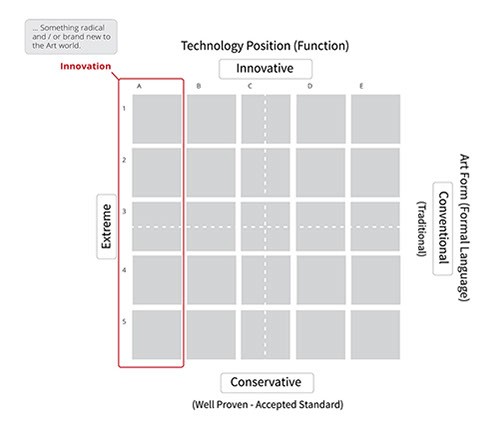

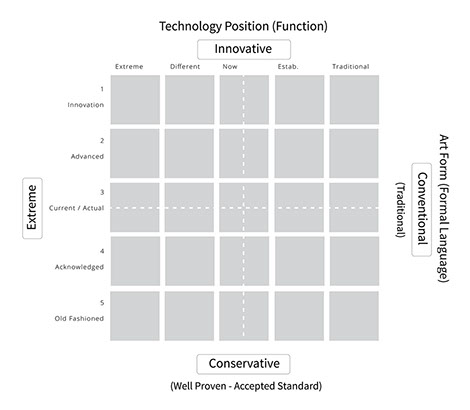
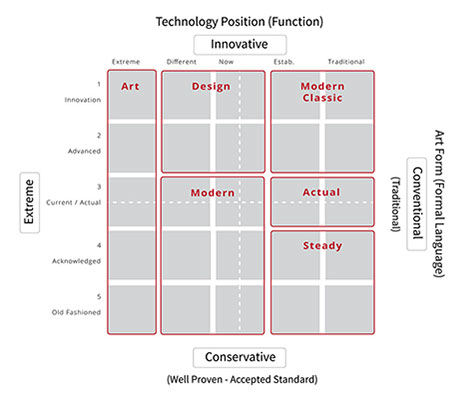
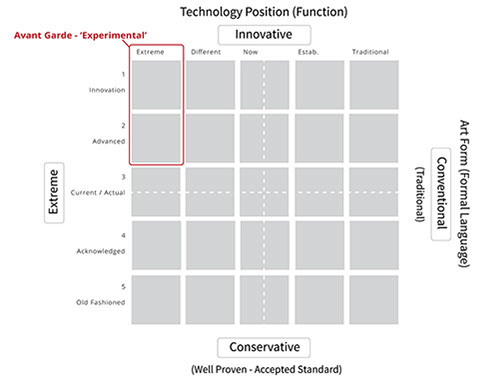


|The Creative Environment - The influence of Priming
Video clip was taken from 'The People Watchers', produced by the BBC by Professor Richard Wiseman. The clip demonstrates how the influence of 'priming', which is a known psychological technique, is used for influencing our thoughts and actions, in this case to increase levels of creativity. For those who are interested we have produced the 'arrow' artwork used in this clip.
Original copyright acknowledged and respected.
|Who Should Attend...
The following delegates / members of the Stakeholder Management Team (SMT) should attend the Idea Generation workshop.
Key / Definition:‐
Monitor: Oversees the overall process, required to provide top level strategic objectives as required,
performs a management role.
Core: Defines the ‘Core’ team headed (chaired) by the Product Manager required to attend the workshop in alignment with the ‘Product Phase’. Membership is mandatory.
Sec. Mem: Secondary Membership defines an ‘on‐standby’ membership requirement and will depend upon the subject area, phase alignment and the project status. Membership is managed by the Product Manager.
On Req. : On Request membership defines a membership that is managed by the Product Manager.
|Related Procedures
The following interrelationship maps indicate; suggested content from other models/processes which may have influence or an effect on the analysis of the title process. The left-hand column indicates information or impact from the named process and the left-hand column indicates on completion of the process/analysis it may have an influence or effect on the listed processes.
Note: A complete set (professional quality) of PMM interrelationship cards are available to purchase - please contact us for further details.
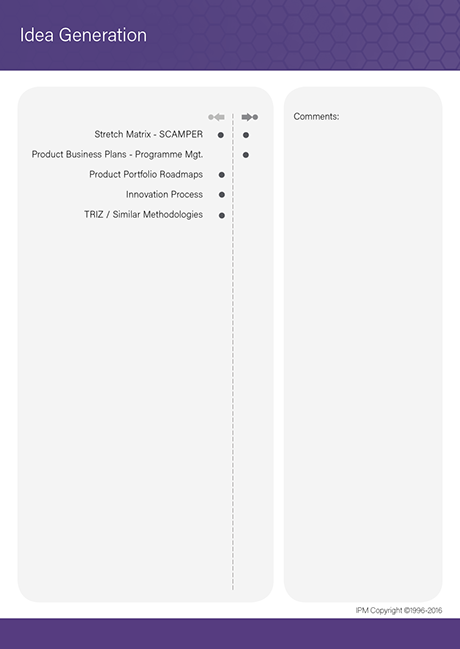
|Strategic Business Models, Workshop Tools & Professional Resources
The IPM practitioner series, is a definitive and integrated training programme for management professionals operating in the Product Management arena. So whether you’re the Managing Director, Product Director, Product Manager or a member of the Multidisciplinary Team we are confident that you will find this particular training series to be one of the best available and an invaluable asset to both you and your company.
PMM - Professional Support
Interactive Business Models







